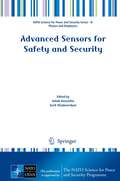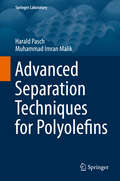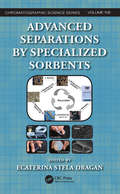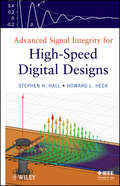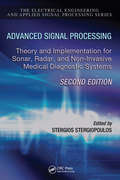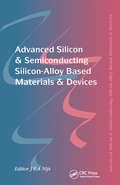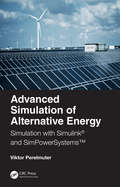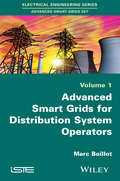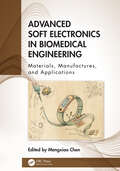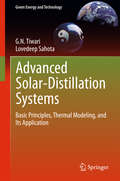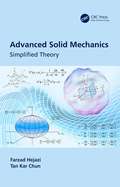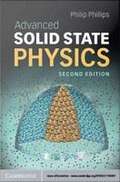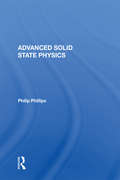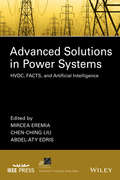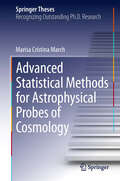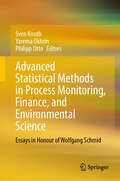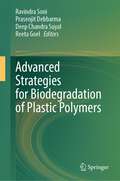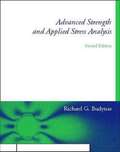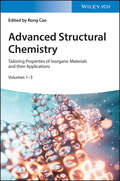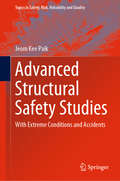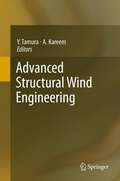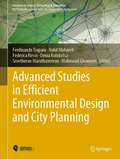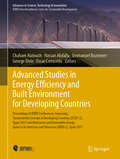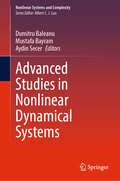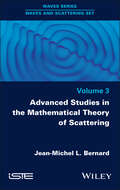- Table View
- List View
Advanced Sensors for Safety and Security (NATO Science for Peace and Security Series B: Physics and Biophysics)
by Ashok Vaseashta Surik KhudaverdyanThis book results from a NATO Advanced Research Workshop titled "Technological Innovations in CBRNE Sensing and Detection for Safety, Security, and Sustainability" held in Yerevan, Armenia in 2012. The objective was to discuss and exchange views as to how fusion of advanced technologies can lead to improved sensors/detectors in support of defense, security, and situational awareness. The chapters range from policy and implementation, advanced sensor platforms using stand-off (THz and optical) and point-contact methods for detection of chemical, nuclear, biological, nuclear and explosive agents and contaminants in water, to synthesis methods for several materials used for sensors. In view of asymmetric, kinetic, and distributed nature of threat vectors, an emphasis is placed to examine new generation of sensors/detectors that utilize an ecosystems of innovation and advanced sciences convergence in support of effective counter-measures against CBRNE threats. The book will be of considerable interest and value to those already pursuing or considering careers in the field of nanostructured materials, and sensing/detection of CBRNE agents and water-borne contaminants. For policy implementation and compliance standpoint, the book serves as a resource of several informative contributions. In general, it serves as a valuable source of information for those interested in how nanomaterials and nanotechnologies are advancing the field of sensing and detection using nexus of advanced technologies for scientists, technologists, policy makers, and soldiers and commanders.
Advanced Separation Techniques for Polyolefins (Springer Laboratory)
by Harald Pasch Muhammad Imran MalikThis Springer Laboratory volume introduces the reader to advanced techniques for the separation and fractionation of polyolefins. It includes detailed information on experimental protocols and procedures, addressing the experimental background of different polyolefin fractionation techniques in great detail. The book summarizes important applications in all major fractionation methods with emphasis on multidimensional analytical approaches. It comprises the most powerful modern techniques, such as high temperature size exclusion chromatography (HT-SEC) for molar mass analysis, temperature rising elution fractionation (TREF) and crystallization analysis fractionation (CRYSTAF) for the analysis of chemical composition and branching, high temperature two-dimensional liquid chromatography (HT-2D-LC), solvent and temperature gradient interaction chromatography (SGIC and TGIC) and crystallization elution fractionation (CEF). Beginners as well as experienced chromatographers will benefit from this concise introduction to a great variety in instrumentation, separation procedures and applications. With detailed descriptions of experimental approaches for the analysis of complex polyolefins, the readers are offered a toolbox to solve simple as well as sophisticated separation tasks. The book starts with an introduction into the molecular complexity of polyolefins - the most widely used synthetic polymers with rapidly growing production capacities. It systematically discusses crystallization based fractionation techniques including TREF, CRYSTAF and CEF and column chromatographic techniques for molar mass, chemical composition and microstructure, as well as the combination of different fractionations in multidimensional experimental setups. This book also includes basic information on the application of high-temperature field-flow fractionation.
Advanced Separations by Specialized Sorbents (Chromatographic Science Series)
by Ecaterina Stela DraganAdvanced Separations by Specialized Sorbents opens a new window into sorbent materials, presenting fundamental principles for their syntheses and adsorption properties. The book presents advanced techniques used to create specialized sorbents with a wide range of functions that can be used to enhance the separation and/or purification of useful bio
Advanced Signal Integrity for High-Speed Digital Designs
by Stephen H. Hall Howard L. HeckA synergistic approach to signal integrity for high-speed digital designThis book is designed to provide contemporary readers with an understanding of the emerging high-speed signal integrity issues that are creating roadblocks in digital design. Written by the foremost experts on the subject, it leverages concepts and techniques from non-related fields such as applied physics and microwave engineering and applies them to high-speed digital design--creating the optimal combination between theory and practical applications.Following an introduction to the importance of signal integrity, chapter coverage includes:Electromagnetic fundamentals for signal integrityTransmission line fundamentalsCrosstalkNon-ideal conductor models, including surface roughness and frequency-dependent inductanceFrequency-dependent properties of dielectricsDifferential signalingMathematical requirements of physical channelsS-parameters for digital engineersNon-ideal return paths and via resonanceI/O circuits and modelsEqualizationModeling and budgeting of timing jitter and noiseSystem analysis using response surface modelingEach chapter includes many figures and numerous examples to help readers relate the concepts to everyday design and concludes with problems for readers to test their understanding of the material. Advanced Signal Integrity for High-Speed Digital Designs is suitable as a textbook for graduate-level courses on signal integrity, for programs taught in industry for professional engineers, and as a reference for the high-speed digital designer.
Advanced Signal Processing: Theory and Implementation for Sonar, Radar, and Non-Invasive Medical Diagnostic Systems, Second Edition (Electrical Engineering & Applied Signal Processing Series)
by Stergios StergiopoulosDiscover the Applicability, Benefits, and Potential of New Technologies As advances in algorithms and computer technology have bolstered the digital signal processing capabilities of real-time sonar, radar, and non-invasive medical diagnostics systems, cutting-edge military and defense research has established conceptual similarities in these areas. Now civilian enterprises can use government innovations to facilitate optimal functionality of complex real-time systems. Advanced Signal Processing details a cost-efficient generic processing structure that exploits these commonalities to benefit commercial applications. Learn from a Renowned Defense Scientist, Researcher, and Innovator The author preserves the mathematical focus and key information from the first edition that provided invaluable coverage of topics including adaptive systems, advanced beamformers, and volume visualization methods in medicine. Integrating the best features of non-linear and conventional algorithms and explaining their application in PC-based architectures, this text contains new data on: Advances in biometrics, image segmentation, registration, and fusion techniques for 3D/4D ultrasound, CT, and MRI Fully digital 3D/ (4D: 3D+time) ultrasound system technology, computing architecture requirements, and relevant implementation issues State-of-the-art non-invasive medical procedures, non-destructive 3D tomography imaging and biometrics, and monitoring of vital signs Cardiac motion correction in multi-slice X-ray CT imaging Space-time adaptive processing and detection of targets interference-intense backgrounds comprised of clutter and jamming With its detailed explanation of adaptive, synthetic-aperture, and fusion-processing schemes with near-instantaneous convergence in 2-D and 3-D sensors (including planar, circular, cylindrical, and spherical arrays), the quality and illustration of this text’s concepts and techniques will make it a favored reference.
Advanced Silicon & Semiconducting Silicon-Alloy Based Materials & Devices
by Johan F A NijsOne of the first books to cover advanced silicon-based technologies, Advanced Silicon and Semiconducting Silicon Alloy-Based Materials and Devices presents important directions for research into silicon, its alloy-based semiconducting devices, and its development in commercial applications. The first section deals with single/mono crystalline silicon, focusing on the effects of heavy doping; the structure and electronic properties of defects and their impact on devices; the MBE of silicon, silicon alloys, and metals; CVD techniques for silicon and silicon germanium; the material properties of silicon germanium strained layers; silicon germanium heterojunction bipolar applications; FETs, IR detectors, and resonant tunneling devices in silicon, silicon germanium, and d-doped silicon; and the fascinating properties of crystalline silicon carbide and its applications. The second section explores polycrystalline silicon. It examines large grain polysilicon substrates for solar cells; the properties, analysis, and modeling of polysilicon TFTs; the technology of polysilicon TFTs in LCD displays; and the use of polycrystalline silicon and its alloys in VLSI applications. With contributors from leading academic and industrial research centers, this book provides wide coverage of fabrication techniques, material properties, and device applications.
Advanced Simulation of Alternative Energy: Simulation with Simulink® and SimPowerSystems™
by Viktor M. PerelmuterAdvanced Simulation of Alternative Energy: Simulations with Simulink® and SimPowerSystems™ considers models of new and promising installations of renewable energy sources, as well as the new trends in this technical field. The book is focused on wind generators with multiphase generators, models of different offshore parks, wind shear and tower shadow effect, active damping, system inertia support, synchronverter modeling, photovoltaic cells with cascaded H-Bridge multilevel inverters, operation of fuel cells with electrolyzers and microturbines, utilization of ocean wave and ocean tide energy sources, pumped storage hydropower simulation, and simulation of some hybrid systems. Simulink® and its toolbox, SimPowerSystems™ (its new name Electrical/Specialized Power Systems), are the most popular means for simulation of these systems. More than 100 models of the renewable energy systems that are made with use of this program environment are appended to the book. The aims of these models are to aid students studying various electrical engineering fields including industrial electronics, electrical machines, electrical drives, and production and distribution of electrical energy; to facilitate the understanding of various renewable energy system functions; and to create a platform for the development of systems by readers in their fields. This book can be used by engineers and investigators as well as undergraduate and graduate students to develop new electrical systems and investigate the existing ones.
Advanced Smartgrids for Distribution System Operators
by Marc BoillotThe dynamic of the Energy Transition is engaged in many region of the World. This is a real challenge for electric systems and a paradigm shift for existing distribution networks. With the help of "advanced" smart technologies, the Distribution System Operators will have a central role to integrate massively renewable generation, electric vehicle and demand response programs. Many projects are on-going to develop and assess advanced smart grids solutions, with already some lessons learnt. In the end, the Smart Grid is a mean for Distribution System Operators to ensure the quality and the security of power supply.Several books have been written to provide a definition of Smart grids, explore the different technical evolution needed and explain / analyse what would be the benefits. All those books are conducted on theoretical basis by academics and strategy consultants. This new book will propose a complementary and singular approach based on a practical experience from DSO's.
Advanced Soft Electronics in Biomedical Engineering: Materials, Manufactures, and Applications
by Mengxiao ChenThe book presents the latest advances in soft electronics in biomedical engineering and its potential applications in various biomedical fields.The contributors provide comprehensive coverage of how soft electronics are used in diagnostics and monitoring, medical therapy, neural engineering, and wearable and implantable systems. In particular, some emerging research areas such as advanced soft robotics, fiber sensing technologies, and power optimization strategies are explored. In addition, the book highlights international standardization activities in wearable technologies and implantable bioelectronics.The book will benefit researchers, engineers, and advanced students in biomedical engineering, electrical and computer engineering, and materials science.
Advanced Solar-Distillation Systems: Basic Principles, Thermal Modeling, and Its Application (Green Energy and Technology)
by G. N. Tiwari Lovedeep SahotaThis book is primarily intended to serve as a textbook and reference work for graduate and professional training coursework on solar desalination of water. The book begins with an introduction to the increasing demand for potable water, various types of water pollution and its impacts on human health, and goes on to cover basics of desalination technologies. It covers all aspects of solar-energy based distillation and desalination for producing potable water resources, including radiation and heat transfer concepts, a history of solar distillation systems, and background on solar collectors. The contents include thermal modeling and parametric study of solar distillation. Energy and exergy aspects are analyzed in detail, including energy matrices of solar distillation. A special chapter on exeroeconomics introduces fundamental equations which include the general balance equation, thermodynamic balance equations, and economic balance equations. A chapter on Economic Analysis of Solar Distillation completes the coverage. The book includes solved examples and end-of-chapter exercises in the form of both problems and objective-type questions. The contents of this book are useful to students, researchers, professionals, and policymakers looking for a comprehensive resource on solar desalination.
Advanced Solid Mechanics: Simplified Theory
by Farzad Hejazi Tan Kar ChunThe main aim of this book is to demonstrate the fundamental theory of advanced solid mechanics through simplified derivations with details illustrations to deliver the principal concepts. It covers all conceptual principals on two- and three-dimensional stresses, strains, stress-strain relations, theory of elasticity and theory of plasticity in any type of solid materials including anisotropic, orthotropic, homogenous and isotropic. Detailed explanation and clear diagrams and drawings are accompanied with the use of proper jargons and notations to present the ideas and appropriate guide the readers to explore the core of the advanced solid mechanics backed by case studies and examples. Aimed at undergraduate, senior undergraduate students in advanced solid mechanics, solid mechanics, strength of materials, civil/mechanical engineering, this bookProvides simplified explanation and detailed derivation of correlation and formula implemented in advanced solid mechanics Covers state of two and three-dimensional stresses and strains in solid materials in various conditionsDescribes principal constitutive models for various type of materials include of anisotropic, orthotropic, homogenous and isotropic materials. Includes stress-strain relation and theory of elasticity for solid materials. Explores inelastic behaviour of material, theory of plasticity and yielding criteria.
Advanced Solid State Physics
by Philip PhillipsProviding an up-to-date and lucid presentation of phenomena across modern advanced-level solid state physics, this new edition builds on an elementary understanding to introduce students to the key research topics with the minimum of mathematics. It covers cutting-edge topics, including electron transport and magnetism in solids. It is the first book to explain topological insulators and strongly correlated electrons. Explaining solid state physics in a clear and detailed way, it also has over 50 exercises for students to test their knowledge. In addition to the extensive discussion of magnetic impurity problems, bosonization, quantum phase transitions, and disordered systems from the first edition, the new edition includes such topics as topological insulators, high-temperature superconductivity and Mott insulators, renormalization group for Fermi liquids, spontaneous symmetry breaking, zero and finite-temperature Green functions, and the Kubo formalism. Figures from the book and solutions to student exercises are available online at www. cambridge. org/solidstate.
Advanced Solid State Physics
by Philip PhillipsSolid state physics continues to be the most rapidly growing subdiscipline in physics. As a result, entering graduate students wishing to pursue research in this field face the daunting task of not only mastering the old topics but also gaining competence in the problems of current interest, such as the fractional quantum Hall effect, strongly correlated electron systems, and quantum phase transitions. This book is written to serve the needs of such students. I have attempted in this book to present some of the standard topics in a way that makes it possible to move smoothly to current material. Hence, all the interesting topics are not presented at the end of the book. For example, immediately after the first 50 pages, Anderson's analysis of local magnetic moments is presented as an application of Hartree-Fock theory; this affords a discussion of the relationship with the Kondo model and how scaling ideas can be used to uncloak low-energy physics. As the key problems of current interest in solid state involve some aspects of electron-electron interactions or disorder or both, I have focused on the archetypal problems in which such physics is central. However, only those problems in which there is a consensus view are discussed extensively. In addition, I have placed the emphasis on physics rather than on techniques. Consequently, I focus on a clear presentation of the phenomenology along with a pedagogical derivation of the relevant equations. A key goal of the detailed derivations is to make it possible for the students who have read this book to immediately comprehend research papers on related topics. A key omission in this book is magnetism beyond the Stoner criterion and local magnetic moments. This omission has arisen primarily because the topic is adequately treated in the book by Assa Auerbach.
Advanced Solutions in Power Systems: HVDC, FACTS, and Artificial Intelligence
by Mircea Eremia Abdel-Aty Edris Chen-Ching LiuProvides insight on both classical means and new trends in the application of power electronic and artificial intelligence techniques in power system operation and control This book presents advanced solutions for power system controllability improvement, transmission capability enhancement and operation planning. The book is organized into three parts. The first part describes the CSC-HVDC and VSC-HVDC technologies, the second part presents the FACTS devices, and the third part refers to the artificial intelligence techniques. All technologies and tools approached in this book are essential for power system development to comply with the smart grid requirements. Discusses detailed operating principles and diagrams, theory of modeling, control strategies and physical installations around the world of HVDC and FACTS systems Covers a wide range of Artificial Intelligence techniques that are successfully applied for many power system problems, from planning and monitoring to operation and control Each chapter is carefully edited, with drawings and illustrations that helps the reader to easily understand the principles of operation or application Advanced Solutions in Power Systems: HVDC, FACTS, and Artificial Intelligence is written for graduate students, researchers in transmission and distribution networks, and power system operation. This book also serves as a reference for professional software developers and practicing engineers.
Advanced Statistical Methods for Astrophysical Probes of Cosmology (Springer Theses)
by Marisa Cristina MarchThis thesis explores advanced Bayesian statistical methods for extracting key information for cosmological model selection, parameter inference and forecasting from astrophysical observations. Bayesian model selection provides a measure of how good models in a set are relative to each other - but what if the best model is missing and not included in the set? Bayesian Doubt is an approach which addresses this problem and seeks to deliver an absolute rather than a relative measure of how good a model is. Supernovae type Ia were the first astrophysical observations to indicate the late time acceleration of the Universe - this work presents a detailed Bayesian Hierarchical Model to infer the cosmological parameters (in particular dark energy) from observations of these supernovae type Ia.
Advanced Statistical Methods in Process Monitoring, Finance, and Environmental Science: Essays in Honour of Wolfgang Schmid
by Sven Knoth Philipp Otto Yarema OkhrinThis book presents a unique collection of contributions on modern methods and applications in three key areas of statistics, celebrating the significant work of Wolfgang Schmid in this field. It is structured thematically into parts focusing on statistical process monitoring, financial statistics, and spatial statistics with environmetrics, each featuring chapters from leading experts. The opening articles on statistical process monitoring present novel methodologies for the detection of anomalies and control charting techniques, which are crucial for maintaining quality in manufacturing processes. Detailed discussions are included on integrating multivariate statistical methods and real-time monitoring to enhance process reliability and efficiency. The part on financial statistics explores rigorous approaches in financial econometrics, with an emphasis on dynamic modelling of market volatility and risk assessment. Contributions cover advanced asset allocation strategies, leveraging high-dimensional data analysis, and the application of machine learning techniques. Spatial statistics and environmetrics are addressed through innovative research on the statistical analysis of environmental data. This includes the use of geostatistical models and hybrid models that combine traditional statistical techniques with machine learning to improve the prediction of environmental phenomena. Key topics here involve the modelling of extremes and airborne pollutants, the prediction of earthquakes using a smartphone-based sensor network, and reviews of selected topics essential in modern spatial statistics. Each part not only reflects Wolfgang Schmid’s interests and impact in these areas but also provides detailed theoretical and applied studies, demonstrating how these sophisticated statistical methods can be effectively employed in practical scenarios. This makes the book an indispensable resource for researchers and practitioners looking to apply cutting-edge statistical techniques in these complex fields.
Advanced Strategies for Biodegradation of Plastic Polymers
by Reeta Goel Ravindra Soni Deep Chandra Suyal Prasenjit DebbarmaSynthetic plastic offers a wide range of utilities because of its physico-chemical properties, thus the demand for its commercial availability and generation of waste is inevitable. Although the scientists have proved over the years that plastics can be efficiently biodegraded by different potential microorganisms, this sustainable green technology is still in the cocoon phase and overlooked by the industry and government as well. Therefore, this book will showcase the cutting-edge microbial tools to mitigate the plastic waste sustainably in consideration of latest technologies and recent strategic advancements besides discussing the global plastic production and their impacts on environment. It will also provide the present status and future perspectives of the environmental clean-up technologies. Moreover, it is an effort to ascertain the potential areas for large-scale biodegradation or pilot scale or start-up ventures in the field of plastic remediation strategy.
Advanced Strength And Applied Stress Analysis
by Richard G. BudynasThis book provides a broad and comprehensive coverage of the theoretical, experimental, and numerical techniques employed in the field of stress analysis. Designed to provide a clear transition from the topics of elementary to advanced mechanics of materials. Its broad range of coverage allows instructors to easily select many different topics for use in one or more courses. The highly readable writing style and mathematical clarity of the first edition are continued in this edition. Major revisions in this edition include: an expanded coverage of three-dimensional stress/strain transformations; additional topics from the theory of elasticity; examples and problems which test the mastery of the prerequisite elementary topics; clarified and additional topics from advanced mechanics of materials; new sections on fracture mechanics and structural stability; a completely rewritten chapter on the finite element method; a new chapter on finite element modeling techniques employed in practice when using commercial FEM software; and a significant increase in the number of end of chapter exercise problems some of which are oriented towards computer applications.
Advanced Structural Chemistry: Tailoring Properties of Inorganic Materials and their Applications
by CaoDiscover the relationships between inorganic chemical synthesis, structure, and property with these comprehensive and insightful volumes Advanced Structural Chemistry: Tailoring Properties of Inorganic Materials and their Applications (3 Volume Set) offers readers the opportunity to discover the relationship between the structure and function of matter, develop efficient and precise synthesis methodology, and to understand the theoretical tools for new functional substances. Advanced Structural Chemistry clarifies the relationships between synthesis and structure, as well as structure and property, both of which are central to the creation of new materials with unique functions. In addition to subjects like the syntheses of metal-oxide clusters, metal-organic cages, and metal-organic frameworks with tailored optical, electric, ferroelectric, magnetic, adsorption, separation, and catalytic properties, the accomplished editor Rong Cao provides readers with information on a wide variety of topics, such as: Coordination-assembled metal-organic macrocycles and cages, including metallacycles and metallacages The structural chemistry of metal-oxo clusters, including the oxo clusters of transitionmetal, main group metal, and lanthanides Synthetic approaches, structural diversities, and biological aspects of molybdenum-based heterometallic sulfide clusters and coordination polymers Group 11-15 metal chalcogenides, including discrete chalcogenide clusters synthesized in ionic liquids The structures of metal-organic frameworks, including one-, two-, and three-dimensional MOFs Perfect for inorganic chemists, structural chemists, solid state chemists, material scientists, and solid state physicists, Advanced Structural Chemistry also belongs on the bookshelves of catalytic and industrial chemists who seek to improve their understanding of the structure and functions of inorganic materials.
Advanced Structural Safety Studies: With Extreme Conditions and Accidents (Topics in Safety, Risk, Reliability and Quality #37)
by Jeom Kee PaikThis book describes principles, industry practices and evolutionary methodologies for advanced safety studies, which are helpful in effectively managing volatile, uncertain, complex, and ambiguous (VUCA) environments within the framework of quantitative risk assessment and management and associated with the safety and resilience of structures and infrastructures with tolerance against various types of extreme conditions and accidents such as fires, explosions, collisions and grounding. It presents advanced computational models for characterizing structural actions and their effects in extreme and accidental conditions, which are highly nonlinear and non-Gaussian in association with multiple physical processes, multiple scales, and multiple criteria. Probabilistic scenario selection practices and applications are presented. Engineering practices for structural crashworthiness analysis in extreme conditions and accidents are described. Multidisciplinary approaches involving advanced computational models and large-scale physical model testing are emphasized. The book will be useful to students at a post-graduate level as well as researchers and practicing engineers.
Advanced Structural Wind Engineering
by Yukio Tamura Ahsan KareemThis book serves as a textbook for advanced courses as it introduces state-of-the-art information and the latest research results on diverse problems in the structural wind engineering field. The topics include wind climates, design wind speed estimation, bluff body aerodynamics and applications, wind-induced building responses, wind, gust factor approach, wind loads on components and cladding, debris impacts, wind loading codes and standards, computational tools and computational fluid dynamics techniques, habitability to building vibrations, damping in buildings, and suppression of wind-induced vibrations. Graduate students and expert engineers will find the book especially interesting and relevant to their research and work.
Advanced Studies in Efficient Environmental Design and City Planning (Advances in Science, Technology & Innovation)
by Denia Kolokotsa Nabil Mohareb Mahmoud Ghoneem Ferdinando Trapani Federica Rosso Sreetheran MaruthaveeranThis book explains how learning from past mistakes in urban design can help to enhance sustainable cities and how the principles of Green Urbanism can yield more resilient urban settlements. Environmental design is a fundamental principle in shaping cities. However, environmental challenges like increased resource consumption, water degradation and waste-related issues are among the greatest problems now facing humanity – which is why these issues need to be considered with regard to “smart cities,” either for the development of new urban centers or for the transformation of existing cities. The book not only discusses the importance of integrating sustainability principles in the urban design process, but also demonstrates their application to the development of sustainable cities. As such, the book offers essential information and a source of inspiration for all those who want to build more sustainable cities.
Advanced Studies in Energy Efficiency and Built Environment for Developing Countries: Proceedings of IEREK Conferences: Improving Sustainability Concept in Developing Countries (ISCDC-2), Egypt 2017 and Alternative and Renewable Energy Quest in Architecture and Urbanism (AREQ-2), Spain 2017 (Advances in Science, Technology & Innovation)
by Chaham Alalouch Hassan Abdalla Emmanuel Bozonnet George Elvin Oscar CarracedoThis edited volume consists of three parts. It is a culmination of selected research papers presented at the second version of the international conference on Improving Sustainability Concept in Developing Countries (ISCDC) and the second version of the international conference on Alternative and Renewable Energy Quest in Architecture and Urbanism (AREQ), organized by IEREK in Egypt, 2017. It discusses major environmental issues and challenges which threaten our future. These include climate change impact, environmental deterioration, increasing demand for energy and new approaches for alternative renewable energy sources which became a necessity for survival. In addition to addressing the different environmental issues witnessed today, research presented in this book stressed on the need of sustainably shaping buildings and cities using renewable energy sources. Topics included in this book are (1) Resilience in the Built Environment, (2) Design for energy-efficient architecture and (3) Alternative and Renewable Energy Resources Quest in Architecture and Urbanism. The book is of interest to researchers and academicians who continuously aim to update their knowledge in these fields, as well as decision makers needing the enough knowledge to carry out the right decisions towards the benefit of the environment and society.
Advanced Studies in Nonlinear Dynamical Systems (Nonlinear Systems and Complexity #41)
by Dumitru Baleanu Mustafa Bayram Aydin SecerThis book is a compilation of select chapter from the 2023 International Conference on Nonlinear Science and Complexity. It presents recent advancements, discoveries, and ongoing research in various facets of nonlinear science and complexity. The book covers a broad scope of topics, including nonlinear dynamical systems, complex systems, quantum sensing, and mathematical approaches in biological and economic models. Key subspecialties addressed include nonlinear differential equations, modeling of nonlinear processes in diverse fields such as biology and economics, and innovative computational techniques. Each chapter contributes unique insights into its respective field, providing theoretical analyses, practical applications, and numerical simulations to advance the understanding of complex nonlinear phenomena.
Advanced Studies in the Mathematical Theory of Scattering, Volume 3 (ISTE Invoiced)
by Jean-Michel L. BernardThis book presents a collection of independent mathematical studies, describing the analytical reduction of complex generic problems in the theory of scattering and propagation of electromagnetic waves in the presence of imperfectly conducting objects. Their subjects include: a global method for scattering by a multimode plane; diffraction by an impedance curved wedge; scattering by impedance polygons; advanced properties of spectral functions in frequency and time domains; bianisotropic media and related coupling expressions; and exact and asymptotic reductions of surface radiation integrals. The methods developed here can be qualified as analytical when they lead to exact explicit expressions, or semi-analytical when they drastically reduce the mathematical complexity of studied problems. Therefore, they can be used in mathematical physics and engineering to analyse and model, but also in applied mathematics to calculate the scattered fields in electromagnetism for a low computational cost.
